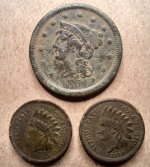Bobadilla
Sr. Member
- Thread starter
- #21
Hi guys,
Bronzecannons,
Thanks for the link, you are right that it is not exact but, at least it can give you some orientation. The problem is that the most interesting treasure shipwrecks were between 1500 and 1750.....
Regarding value taken from Fishers' museum, it is difficult to take it as a base. All artifacts come with the certificate of Atocha, it means that the shipwreck has been already identified and you get an artifact with complete story which puts the price much higher. Here you have some examples of artifacts from Fishers':
High-grade authentic silver coin Reales from the ship sell for anywhere from $4,000 to $14,000. Likewise, an Atocha gold bar is listed for $88,000, an emerald ring for $150,000, a gold filigree locket with gold chain for $400,000, and a gold and emerald brooch for $1.1 million.
One Piece of Eight would never cost USD 26.00. Nowhere. Even here in the Dominican Republic, the third world country, if you are lucky enough to find some of them, generally directly from fishermen or their relatives, you will not get them under USD 200.00 per piece and it would be from unknown shipwreck.
Lobo
Bronzecannons,
Thanks for the link, you are right that it is not exact but, at least it can give you some orientation. The problem is that the most interesting treasure shipwrecks were between 1500 and 1750.....
Regarding value taken from Fishers' museum, it is difficult to take it as a base. All artifacts come with the certificate of Atocha, it means that the shipwreck has been already identified and you get an artifact with complete story which puts the price much higher. Here you have some examples of artifacts from Fishers':
High-grade authentic silver coin Reales from the ship sell for anywhere from $4,000 to $14,000. Likewise, an Atocha gold bar is listed for $88,000, an emerald ring for $150,000, a gold filigree locket with gold chain for $400,000, and a gold and emerald brooch for $1.1 million.
One Piece of Eight would never cost USD 26.00. Nowhere. Even here in the Dominican Republic, the third world country, if you are lucky enough to find some of them, generally directly from fishermen or their relatives, you will not get them under USD 200.00 per piece and it would be from unknown shipwreck.
Lobo






